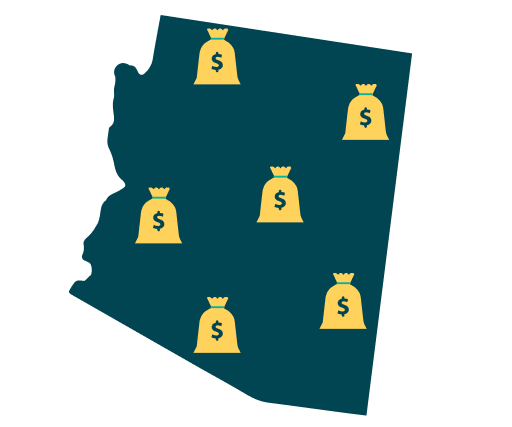Our goal is to give you the tools and confidence you need to improve your finances. Although we receive compensation from our partner lenders, whom we will always identify, all opinions are our own. Credible Operations, Inc. NMLS # 1681276, is referred to here as "Credible."
If you’re planning to attend a college or university in Arizona, you might need the help of scholarships, grants, or Arizona student loans to help you pay for it.
While the cost of going to school in Arizona varies widely depending on the school you choose, you can expect to pay about $23,798 for in-state tuition and $27,174 for out-of-state tuition, according to Education Data.
- Arizona State University: $20,022 to $31,070
- Grand Canyon University: $24,550 to $40,700
- Northern Arizona University: $21,922 to $28,622
- University of Arizona: $20,850 to $30,650
Note: Actual costs might vary depending on your degree program, whether you live on or off campus, and other factors.
Here are four ways to pay for school in Arizona:
- Start with scholarships and grants for Arizona students
- Apply for federal student loans
- Consider a state student loan designed for future teachers
- Use private student loans to fill in the gaps
1. Start with scholarships and grants for Arizona students
If you need to pay for school, it’s usually a good idea to start with college scholarships and grants — mainly because they don’t have to be repaid, unlike student loans. There are also several scholarships and grants available specifically to Arizona students.
Here are a few options to consider:
- Arizona Business and Professional Women’s Foundation Scholarships: These awards are available to Arizona women who are 21 or older and who are attending an Arizona community college.
- Arizona Community Foundation Scholarships: The Arizona Community Foundation lets students complete one general application to apply for over 100 online Arizona scholarships at once.
- Arizona Leveraging Educational Assistance Partnership (AzLEAP) Grants: These need-based grants are worth up to $2,500 and are available to low-income undergraduate students.
- Community Foundation for Southern Arizona Scholarships: These awards are geared toward a wide variety of students in southern Arizona.
Some colleges and universities also offer school-specific grants and scholarships, which are generally awarded based on your FAFSA results.
If scholarships and grants don’t fully cover your costs, you could also consider using federal or private student loans to pay for your other expenses. Just be sure to think about how much a student loan will cost you in the future before you decide to borrow.
You can find out how much you’ll owe over the life of your federal or private student loans using our student loan calculator below.
Enter your loan information to calculate how much you could pay
With a $ loan, you will pay $ monthly and a total of $ in interest over the life of your loan. You will pay a total of $ over the life of the loan, assuming you're making full payments while in school.
Need a student loan?
Compare rates without affecting your credit score. 100% free!
Checking rates won’t affect your credit score.
Learn More: Is My College Housing Covered by Financial Aid?
2. Apply for federal student loans
If you need to borrow money for school, federal student loans are typically a good place to start — mainly because they come with federal benefits and protections, such as access to income-driven repayment and student loan forgiveness programs.
Here are the types of federal student loans you might be eligible for as an Arizona student:
- Direct Subsidized Loans are available to undergraduate students with financial need. The government will cover the interest that accrues on these loans while you’re in school, meaning you’ll have less to pay off later.
- Direct Unsubsidized Loans are available to undergraduate, graduate, and professional students — regardless of financial need. Unlike subsidized loans, you’re responsible for all interest that accrues on unsubsidized loans.
- Direct PLUS Loans come in two types: Grad PLUS Loans for students who want to pay for grad school and Parent PLUS Loans for parents who want to cover their child’s education costs. These loans typically come with higher interest rates than subsidized and unsubsidized loans. They also require a credit check.
| Loan type | Who qualifies? | Interest rates | Loan limits |
|---|---|---|---|
| Direct Subsidized Loans | Undergrad students with financial need | 5.50% | $3,500 to $5,500 per year |
| Direct Unsubsidized Loans | Undergrad, graduate, and professional students | Undergrad: 5.50% Graduate and professional: 7.05% | Dependent undergrad: $5,500 to $7,500 per year ($31,000 total limit) Independent undergrad: $9,500 to $12,500 per school year ($57,500 total limit) Graduate and professional: $20,500 per year ($138,500 total limit) |
| Direct PLUS Loans | Parents, graduate students, and professional students | 8.05% | Cost of attendance minus any other financial aid received |
For example, undergraduate students might be able to borrow up to $12,500 per year in federal loans while graduate students could borrow up to their school’s cost of attendance in Grad PLUS Loans (minus other financial aid they’ve received).
Check Out: On-Campus vs. Off-Campus Costs
3. Consider a state student loan designed for future teachers
If you’re attending a teaching program at a public or private Arizona school, you might be able to take advantage of the Arizona Teacher Student Loan Program. Through this need-based program, you can borrow up to $7,000 per year for up to three academic years.
In return, you must agree to serve as a teacher at an Arizona public school for the number of years you accepted a loan plus one extra year. If you meet this obligation, you could have your teacher student loans fully forgiven.
- Be a U.S. citizen or eligible non-citizen
- Be a resident of Arizona for at least one year prior to applying
- Have financial need
- Be enrolled at least half time at an Arizona public or private school
- Be a junior or senior who is enrolled in a teaching degree or alternative teacher certification
- Plan to be licensed as a teacher in math, science, or special education or plan to work at a school that is low-income, located in a rural area, or located on an Indian reservation
Learn More: Low-Interest Student Loans
4. Use private student loans to fill in the gaps
If you’ve exhausted your scholarship, grant, and federal student loan options, private student loans could help fill any financial gaps left over.
Private student loans don’t offer the same protections as federal student loans, such as access to income-driven repayment or student loan forgiveness programs.
However, if you’re considering federal vs. private student loans, keep in mind that they do offer some benefits of their own, such as:
- Higher borrowing limits: You might be able to borrow up to your school’s cost of attendance.
- Potentially lower interest rates: You might qualify for a lower interest rate than you’d get on a federal loan, depending on your credit.
- Might be available for other types of schooling: Depending on the lender, you might be able to use a private loan to pay for non-traditional schooling options, such as coding bootcamps or trade schools.
If you’re struggling to get approved, another option is applying with a cosigner. Even if you don’t need a cosigner to qualify, having one could get you a lower interest rate than you’d get on your own.
If you decide to take out a private student loan, be sure to consider as many lenders as possible to find the right loan for you.
Credible makes this easy — you can compare your prequalified rates from our partner lenders in the table below in two minutes. Plus, all of these lenders are available in Arizona.
| Lender | Fixed rates from (APR) | Variable rates from (APR) | Loan terms (years) | Loan amounts |
|---|---|---|---|---|
 | 3.79%+10 | 5.99%+10 | 5, 7, 10, 12, 15, 20 (depending on loan type) | $2,001* to $400,000 |
|
||||
 | 4.24%+1 | 5.99%+ | 5, 10, 15 | $1,000 to $350,000 (depending on degree) |
|
||||
 |
3.99%+2,3
| 5.59%+2,3 | 5, 8, 10, 15 | $1,000 up to 100% of the school-certified cost of attendance |
|
||||
 | 5.75%+ | N/A | 10, 15 | $1,500 or $2,000 up to school’s certified cost of attendance (depending on school type and minus other aid received) |
|
||||
 | 4.150%9 - 15.49%9 | 5.37%9 - 15.70%9 | 10 to 20 | $1,000 up to 100% of the school-certified cost of attendance |
|
||||
your credit score. 100% free! Compare Now |
||||
Lowest APRs reflect autopay, loyalty, and interest-only repayment discounts where available | Read our full methodology | 10Ascent Disclosures | 1Citizens Disclosures | 2,3College Ave Disclosures | 11Custom Choice Disclosures | 7EDvestinU Disclosures | 8INvestEd Disclosures | 9Sallie Mae Disclosures |
||||
Students in Arizona have plenty of options to pay for college
Paying for college can be difficult, but thankfully, there are plenty of options that could help you cover the cost.
Remember to start with financial aid that doesn’t have to be repaid like scholarships and grants before moving on to federal student loans and finally private student loans.
If a private student loan seems right for you, be sure to consider as many lenders as you can to find a loan that suits your needs. Credible makes this easy — you can compare your prequalified rates from multiple lenders in two minutes.
See Your Rates
Checking rates will not affect your credit
Keep Reading: How to Get a Student Loan for Online College




